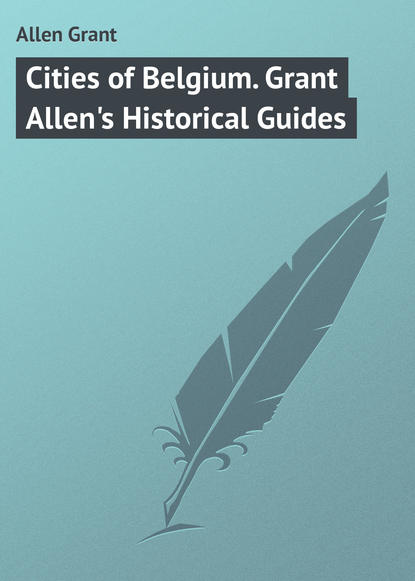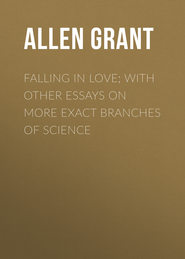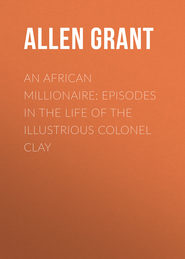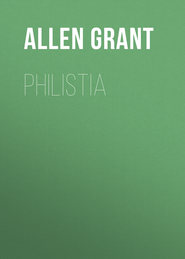По всем вопросам обращайтесь на: info@litportal.ru
(©) 2003-2024.
✖
Cities of Belgium. Grant Allen's Historical Guides
Настройки чтения
Размер шрифта
Высота строк
Поля
445. A very characteristic and excellent Jan Steen, known as *The Rhetoricians – that is to say, members of a Literary Club or Debating Society, one of whom is engaged in reading his prize verses to a not too appreciative audience outside. Even here, however, Jan cannot omit his favourite touch of coarse Dutch love-making, with a tavern-girl introduced out of pure perversity.
357. Paul Potter: *Pigs. Admirably piggy.
End wall.
223. More of Hondecoeter’s unimpeachable *poultry.
48. Bol: *Portrait of a Mathematician and Anatomist. One of the painter’s masterpieces.
367. **Splendid portrait by Rembrandt (“L’Homme au grand chapeau”). An excellent and characteristic example of his art. The light and shade, the painting of the hair, and the masterly handling of the robe are all in the great painter’s noblest manner.
402. Capital *water scene by S. van Ruysdael: a ferry on the Meuse.
224. Hondecoeter. More poultry, this time dead, with realistic nails, and other little tricks to catch the great public.
Left wall (R. of door).
88. Van der Capelle: Calm sea, with excellent fishing boats.
Now, return through Corridors A. and D. to
Room VII
containing the early Italian pictures. Few of these are of much value, and as they are not connected with Flanders or Brabant, I will not enlarge upon them. Right of door,
631. An early Italian Adoration of the Magi, where you may compare the Three Kings, Joseph with the gift, the ox and ass, etc., with Flemish examples.
631 (left) is a characteristic example of St. Francis receiving the stigmata. Study it for comparison with the Rubens at Ghent, and others.
628. Above is a set of panels containing events in the History of Our Lady. I give the subjects, running along the top row first, with necessary brevity: Joachim expelled from the Temple: Warned by the Angel: Anna warned by the Angel: Meeting of Joachim and Anna at the Golden Gate: Birth of the Virgin: Presentation of the Virgin in the Temple: The Nativity: Adoration of the Magi: Christ found in the Temple: Miracle at Cana: Raising of Lazarus: Death of the Virgin, with Christ receiving her soul as a new-born baby. All these may be studied as early examples of the subjects they represent. Above them, 629 and 630: two Crucifixions of various ages.
140. Good characteristic Carlo Crivelli of *St. Francis with the stigmata.
3. Adam and Eve. Albani.
Above it, a tolerable Veronese of *Juno scattering wealth into the lap of Venice, St. Mark’s lion beside her.
140. Beautiful Carlo Crivelli of *Our Lady and Child. This picture and the corresponding one opposite are parts of a large altar-piece, the main portion of which, a Pietà, is in the National Gallery in London.
415. Vannuchi (not Perugino): Leda and the Swan.
412 is a good portrait of Mary of Austria.
634. A tolerable Marriage of the Virgin.
473. Tintoretto: Portrait of a Venetian gentleman.
474. Another by the same.
Room VIII
opposite, also contains later Italian pictures, with a few French.
472 is a Martyrdom of St. Mark, by Tintoretto.
497 is a Holy Family by Paolo Veronese, with St. Theresa and St. Catherine.
The other works in the room do not call for notice.
Passage leading into Room VI
Skied. 477. Perugino: Madonna and Child, with the infant St. John of Florence, in a frame of Delia Robbia work. This is one of the best Italian pictures in this Gallery, but not a good example. Near it, School of Mantegna, Christ and St. Thomas with St. John the Baptist.
If you want further information about the pictures in the Brussels Gallery, you will find it in Lafenestre and Richtenberger’s La Belgique, in the series of La Peinture en Europe.
CATHEDRAL OF BRUSSELS
D. THE CATHEDRAL
[The Cathedral of Brussels is dedicated to St. Gudula or Ste. Gudule, and to St. Michael the Archangel. Ste. Gudule is a holy person who takes us back to the earlier ages of Christianity among the Middle Franks. She was a member of the family of Pepin d’Heristal, the kinsman of Charlemagne, and she died about 712. She became a nun at Nivelles under her aunt, St. Gertrude. The only fact of importance known as to her life is that she used to rise early, in order to pay her devotions at a distant church, whither she guided her steps by the aid of a lantern. Satan frequently extinguished this light, desiring to lead her feet astray, but the prayers of the saint as often rekindled it. Hence she is usually represented carrying a lantern, with the devil beside her, who endeavours to blow it out.
In the 10th century, the body of Ste. Gudule was brought to Brussels from Morseel; and in the 11th (1047), Lambert, Count of Louvain, built a church on this site above it: but the existing building, still containing the body of the saint, was not begun till 1220.
More important, however, than Ste. Gudule, in the later history of Brussels Cathedral, is the painful mediæval incident of the Stolen Hosts. The Jew-baiting of the 14th century led to a story that on Good Friday, 1370, certain impious Jews had stolen 16 consecrated Hosts from the Cathedral, and sacrilegiously transfixed them with knives in their synagogue. The Hosts miraculously bled, which so alarmed the Jews that they restored them to the altar. Their sacrilege was discovered by the aid of an accomplice, and on this evidence several Jews were burned alive, and the rest banished from Brabant for ever. A chapel on the site of the synagogue still commemorates the event, and the Miracle of the Hosts (as it is called) gives rise to several works of art now remaining in the Cathedral. An annual ceremony (on the Sunday after the 15th of July) keeps green the memory of the miraculous bleeding: the identical wafers are then exhibited. Visit the interior between 12 and 4, when the doors are closed, but will be opened for you by a sacristan in the South Portal, at a charge of 50 c. per head. You will then be able to inspect the whole place peaceably at your leisure. Take your opera-glasses.]
Approach the Cathedral, if possible, from the direction of the Grand’ Place. It is built so as to be first seen from this side, and naturally turns its main West Front towards the older city. Go to it, therefore, by the street known as the Rue de la Montagne and the short (modern) Rue Ste. Gudule, which lead straight up to the handsome (recent) staircase and platform. The building loses much by being approached sideways, as is usually the case, from the Upper Town, which did not exist at all in this direction when the Cathedral was built. Consider it in relation to the nucleus in the valley.
First examine the exterior. The accompanying rough plan will sufficiently explain its various portions.
The façade has two tall towers, and a rather low gable-end, with large West Window. In style, it approaches rather to German than to French Gothic. Over the Principal Entrance are (restored) figures of the Trinity, surrounded by angels, with the Twelve Apostles, each bearing his symbol or the instruments of his martyrdom. Below, on the central pillar, the Three Magi, the middle one a Moor. High up on the gable-end is the figure of Ste. Gudule, the human patron, with the Devil endeavouring to extinguish her lantern. Above her is the other and angelic patron, St. Michael. (These two figures also occur on the middle of the carved wooden doors.) At the sides, two bishops, probably St. Géry and St. Amand. Though the sculpture is modern, it is of interest from the point of view of symbolism. The left portal has St. Joachim, St. Anne, and the education of the Virgin. The right portal has St. Joseph and Our Lady with the Divine Infant.
Now, go round the building to the R., to observe its arrangement. You pass first the chapels or bays of the S. Aisle, with weather-beaten sculpture, and then reach the slightly projecting South Transept. Beyond the South Portal, the Choir is hidden by the addition of a large projecting chapel (that of Notre-Dame-de-Délivrance), whose architecture will be better understood from the interior. At the East End, you get a good view of the Gothic Choir and Apse, with its external chapels and flying buttresses. The extreme East point is occupied by the ugly little hexagonal rococo Chapel of the Magdalen, a hideous addition of the 18th century. Still passing round in the same direction, you arrive at a second projecting Chapel (du Saint Sacremént), which balances the first. The best general view is obtained from the North Side, taking in the beautiful porch of the North Transept. (The handsome Louis XVI. building opposite is the Banque Nationale.)
The Cathedral as an interior is disappointing. It contains no pictures of any importance, and its architecture is less striking within than without. The stained glass, indeed, is famous; none of it, however, is mediæval. The best windows date only from the High Renaissance; the remainder are 17th century or modern.
Walk first into the centre of the Church, where you can gain a good idea of the high Choir, with its Apse and Triforium of graceful Early Gothic architecture, as well as of the short Transepts, the two additional chapels, R. and L., the Nave and single Aisles, and the great west window.
Now, begin the tour of the church with the South Aisle, to the L. as you enter. The glass here is modern. It represents the story of the Stolen Hosts, some of the subjects being difficult to decipher. We see the Jew bribing a Christian, who removes the Hosts in a monstrance: then the Christian departing from the Jewish Synagogue with his ill-gotten gains. The third window I do not understand. After that, we see the Jews betrayed by one of their number; the Miracle of the Blood, with their horror and astonishment; the Recovery of the Hosts; and in the North Aisle, their Return to the Church in procession, and the various miracles afterward wrought by them. I cannot pretend to have deciphered all these accurately. The Nave has the usual Flemish figures of the Twelve Apostles set against the piers, most of them of the 17th century. The great west window has the Last Judgment, by Floris, a poor composition, overcrowded with indistinguishable figures.
The pulpit, by Verbruggen, is one of the usual unspeakable abominations of seventeenth century wood-carving. Below are Adam and Eve driven from Paradise: above, on the canopy, the Virgin and Infant Saviour wound the serpent’s head with the cross: the Tree of Life, supporting the actual platform, gives shelter to incredible birds and animals. This ugly object was made for the Jesuits’ Church at Louvain, and given to the Cathedral by Maria Theresa on the suppression of the Society of Jesus.
Return to the Transepts. The window in the North Transept represents Charles V., kneeling, attended by his patron, Charlemagne, who was a canonized saint, but who bears the sword and orb of empire. Behind him, Charles’s wife Isabella, with her patroness, St. Elizabeth of Hungary, holding the crown. This window, erected in 1538, from designs by Bernard van Orley, was the gift of the Emperor. That in the South Transept represents the Holy Trinity, with King Louis of Hungary kneeling in adoration, attended by his patron, St. Louis of France. Behind him is his Queen, Marie (sister of Charles V.), with her patron, the Blessed Virgin. This window also is by Van Orley.
Now, enter the Chapel by the North Transept, that of the Holy Sacrament, erected in 1535-39, in honour of the Miraculous (Stolen) Hosts, which are still preserved here, and which are carried in procession annually on the Sunday following the 15th of July. The windows in this chapel, each of which bears its date above, were placed in it immediately after its erection, and are the best in the Cathedral. They exhibit the style of the Transitional Renaissance. Each window shows, above, the story of the Stolen Hosts, with, below, the various donors and their patrons. First window as you enter: Above, the Bribery: below, King John III. of Portugal with his patron, St. John-Baptist; and Queen Catherine, his wife (sister of Charles V.), with her patron, St. Catherine, holding her sword of martyrdom and trampling on the tyrant Maximin: (all by Michael Coxcie). Second window: above, the Hosts insulted in the Synagogue: below, Louis of Hungary, with his patron, St. Louis; and Marie, his wife (sister of Charles V.), with her patroness, Our Lady (Coxcie). Third window: above, same subject as in the 3rd of the S. Aisle – perhaps the attack on the Jews: below, Francis I. of France, with his patron, St. Francis, receiving the Stigmata; behind him, Eleonora, his wife (sister of Charles V.), with her patroness, St. Helena (Bernard van Orley). Fourth window: above, Denunciation of the Jews: below, Ferdinand, brother of Charles V., with his patron, St. Ferdinand; and his wife, Anne, with her patron, St. Anna (Bernard van Orley). The end window represents the Adoration of the Holy Sacrament, and of the Lamb that was slain, in a composition suggested by the Van Eyck at Ghent. Below, to the L. are an Emperor and Empress (Charles V. and Isabella), a king and queen, and other representatives of the world secular: to the R. are a pope, a cardinal, bishops, prophets, and other representatives of the church or the world ecclesiastical.
Now, proceed to the opposite chapel, by the S. Transept, that of Our Lady of Deliverance (Notre-Dame de Délivrance). This chapel was erected in 1649-53, to balance that in the N. Transept. Its windows, made after designs by Van Thulden, in 1656, represent the continued decadence of the art of glass-painting. The subjects are taken from the History of Our Lady, above, with the donors and their patrons, princes of the House of Austria, below. Unlike the last, the subjects here begin at the inner end, near the altar. First window: the Presentation of Our Lady in the Temple. She mounts the steps to the High Priest: below are St. Joachim and St. Anna. Second window: The Marriage of the Virgin. Third window: The Annunciation, with the Angel Gabriel and the Dove descending in a glory. Fourth window: The Visitation of Mary to Elizabeth: the figure of Mary, in its odd hat, taken from the Rubens in Antwerp Cathedral. The Austrian Princes and Princesses below, in the insipid taste of the 17th century, have commemorated their own names so legibly on the bases that I need not enumerate them.
Now, return to the N. Transept, to make the tour of the Ambulatory. At the entrance to the Apse, L., is a colossal statue of the patroness, Ste. Gudule, with the Devil under her feet. The stained glass of the Apse is good modern. Notice the fine pillars to your right. The hexagonal rococo Chapel of St. Mary Magdalen, at the end of the Apse, has modern windows of, L. and R., the two patrons, St. Michael and Ste. Gudule, the latter with the lantern and Devil: and, Centre, the Trinity. Exit from the Apse: L., gilded statue of the other patron, St. Michael, to balance the Ste. Gudule. Beside it, curious wooden Easter Sepulchre, with Nicodemus, Joseph of Arimathea, the Mater Dolorosa, and the Maries. Above it, the Risen Christ, with Roman soldiers on the pediment. Fine view from near this point of the Choir and Transepts.











